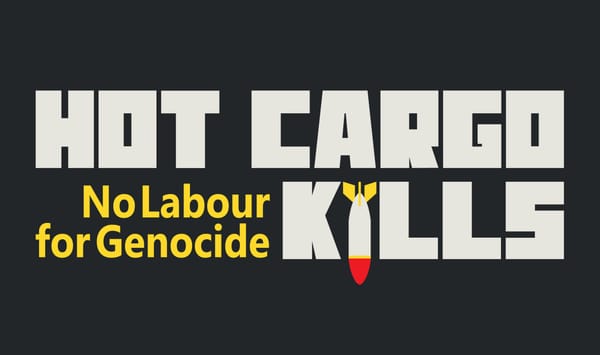
This week I sat down with Judy and Larry Haiven, two retired professors of management and industrial relations at Saint Mary’s University in Halifax to talk about work and labour in the Atlantic provinces.
In 2018, Judy and Larry, along with Liane Tessier, founded Equity Watch, an organization that fights discrimination, bullying, and harassment in the workplace. Equity Watch works with union and worker advocates, supports human rights cases, holds webinars and publishes monographs on current topics in labour and human rights.
Judy also blogs regularly on labour and other topics at “Another Ruined Dinner Party.”
The interview has been edited for length and clarity.
Adam King: When people think of labour in the Atlantic provinces, things like seasonal work in the fisheries or work in other resource extraction might come to mind. What does the labour market look like on Canada’s east coast now?
Larry Haiven: About 20 years ago, three major industries collapsed: coal mining, steel and fisheries. Those were the mainstays of employment and wealth generation here and they ended at roughly the same time.
This was disastrous for the labour movement because coal mining and steelmaking were both heavily unionized. There were also other industries that went along with them. A lot of the heavy industry is now gone. The economy is based largely on tourism at this point. One of the only major industrial employers left is Michelin tires, which has three plants. In fact, the number one export from Nova Scotia is rubber.
Judy Haiven: The infamous ‘Michelin bill’ has also handicapped union organizing. There are three rural plants that Michelin established here in the mid-1970s, which provide roughly 2,500 jobs — a big deal in this province.
In 1979, the government of the day amended the Trade Union Act to require that if a union tried to organize Michelin, all three plants would have to be unionized at the same time. The text of the bill doesn’t actually name Michelin, but instead says that two or more connected manufacturing plants must be organized simultaneously. This is an almost impossible feat. The plants are hundreds of kilometres apart and have had different appetites for labour militancy. Both Unifor and the United Steelworkers have tried to organize them but with no success.
I actually asked Darrell Dexter, the former NDP premier of Nova Scotia, back in 2009, ‘When you get elected, are you going to repeal the Michelin bill?’ He said, ‘Absolutely not,’ that they wouldn’t touch the bill. In my view, the NDP decided to leave labour to languish.
LH: Of course, this goes against the practice of labour boards across the country. Usually, in order for a union to organize more than one location of a firm or employer, you have to prove a “community of interest.” There’s a bunch of law determining what a “community of interest” is, and geographic location is a big part of it. In other words, usually combining worksites goes the other way (i.e., they make it harder for unions to do). This ends up being a huge problem in retail outlets, banks or fast-food restaurants.
But governments often pander to capital. If forcing unions to work location by location works for employers, they do that. In the case of Michelin, they forced unions to combine sites.
AK: Deindustrialization, while a major issue throughout Canada, has had a particularly negative impact on the east coast, particularly in Nova Scotia. In what ways does deindustrialization continue to shape work and labour today?
JH: Deindustrialization is a huge issue. The Cape Breton steel mill was owned completely by the federal government, which was unique. There were also the coal mines. It used to be that Sydney was a richer city than Halifax. Now Sydney is in the doldrums. The rug was basically pulled out from under the major industries.
LH: Because Nova Scotia is ocean bound, tourism has always been a strong industry. But it’s not like heavy industry with blue-collar work. Tourism is sparsely unionized, it’s often seasonal and the pay tends to be low. Many workers depend on Employment Insurance (EI) during the off-season. It doesn’t bring a lot of wealth into the province or a lot of money into government confers.
AK: There is also the issue of precarious employment. My sense is that precarious work is a serious problem in the Atlantic provinces, perhaps more so than in other areas of the country.
JH: As Larry mentioned, most people here are employed in the service industry, particularly the portion that caters to tourism. People try to accumulate enough hours or weeks of work to qualify for EI, which of course only pays 55 per cent of previous earnings.
During the three or so years of COVID-19, much of the industry was ground to a halt. Many people availed themselves of CERB as the tourist industry fell apart. There’s also some light industry around Halifax, but it’s mostly non-union and low-paid as well.
AK: Relatedly, employment standards protections tend to be weaker in the Atlantic provinces. Minimum wages are lower than in the larger provinces or federally, Newfoundland and New Brunswick both allow employers to pay one and a half times the minimum wage as an overtime rate, no matter the worker’s salary, and there are fewer public holidays.
JH: Yes, and keep in mind that the overtime hours threshold is quite high. In Nova Scotia, for example, workers only earn overtime pay after 48 hours of work, rather than the standard of 40.
Previously, Larry and I, along with Kyle Buott, have written about the problems with employment standards in Nova Scotia.
LH: More recently, Rebecca Casey at Acadia University has updated the critique of labour standards here.
We’re behind on overtime rules, but Nova Scotia also only provides six paid public holidays, where other Canadian jurisdictions have nine or 10. Remembrance Day has its own act and separate day.
JH: The other difficulty is that there is something called “retail closing days” here. Across the calendar, there are nine additional days where stores close, people can’t work, but they don’t get a paid day off. It’s something I’ve never seen before. I call this a “punitive holiday.”
AK: What explains these weaker employment standards? Is it an attempt to draw investment east, a lack of organization and pressure from labour, employer-friendly governments, or some combination of these factors?
LH: It’s the culmination of a long tradition of trying to attract investment through the weakening of labour. High wages and worker protections are viewed as a hindrance. We have among the lowest average wages in the country. It’s the low-road strategy.
It’s not just employment standards. For instance, all other provinces have psychological injury in their occupational health and safety legislation. In many provinces it’s also covered by workers’ compensation, so workers can file claims for benefits. Nova Scotia is the only province that doesn’t have this. It’s a symptom of how backward the province is in its labour law.
JH: The minimum wage is also way behind. There are plans to bring it to $15 per hour, but it’s not going to help much. Here in Halifax — a city of 430,000 people — the living wage is $26.50 per hour, according to the latest study from the Canadian Centre for Policy Alternatives. The wage required for a decent standard of living has risen 14 per cent. Even this is really only enough to live a basic existence. The cost-of-living is high. Rents are still very high. In actual fact, $26.50 would be considered a professional wage. It’s rare to hear someone earning that much.
There are also a lot of students here. There are three universities in the city and three in the broader hinterland of the province. Many of these students are working for minimum wage.
AK: That there is such a large educational sector is notable. People might typically think postsecondary institutions are ‘good’ employers, but they are also sites of a lot of precarious employment, not only in terms of contract faculty but also when it comes to many of the service workers on campuses.
LH: Yes, postsecondary is a big employer here. Nova Scotia has more universities per capita than any other province. Although this involves some government expenditure, it also brings in a lot of revenue to the province because foreign students pay such high tuition.
At Cape Breton University in Sydney, for example, 70 per cent of the students are from outside of Canada. There are often no jobs or adequate housing for them.
JH: Over the past two years, teaching assistants and other staff have been striking more frequently. At Dalhousie, the teaching assistants (TAs) had a very spirited strike and won quite a lot. After that, about 150 TAs at Saint Mary’s, where we used to teach, organized into the same local of CUPE. At Mount Saint Vincent, also in Halifax, they also recently unionized. [EDITOR’S NOTE: In fact, 325 TAs joined the Canadian Union of Public Employees. Also, workers at the Nova Scotia College of Art and Design recently unionized, not those at Mount Saint Vincent.]
Overall, what we’re seeing is that many people — students, academic staff, part-time students, people with graduate degrees unable to find stable employment — are all facing terrible precarity.
AK: Union density overall has remained relatively stable in the Atlantic provinces, though private sector density has declined as in all of Canada. Newfoundland and Labrador continues to have the highest unionization in Canada, just ahead of Quebec, while the other provinces sit more or less around the nationwide average. Where are union members concentrated in the Atlantic provinces?
JH: In the private sector in Halifax, union membership is concentrated at the Irving Shipyard on the waterfront. These workers are members of Unifor. Every year they seem to have wildcat strikes because conditions are so bad and management is brutal.
There are still some mining operations that are unionized, but they’re very small. Also, much of the media is organized. Halifax is the Atlantic centre for media, so the Teamsters have organized CTV. At Global and the CBC, workers are also unionized. There’s also the airport, from airline staff to ground crews and others.
Many unions here are unfortunately reluctant to organize. From what I can tell, there’s virtually no new organizing going on. Instead, raiding is a big problem here. It’s happened in hotels and restaurants and in other sectors.
AK: At the same time, whole industries where unions are present in other provinces are entirely non-union in parts of the east coast, such as grocery stores.
JH: The grocery sector is all non-union here on mainland Nova Scotia. [EDITOR’S NOTE: In fact, in March, Pete’s Frootique & Fine Foods in downtown Halifax, a subsidiary of Sobeys, unionized with SEIU Local 2.] The UFCW [United Food and Commercial Workers] had some of it organized until about 2001 and then it fell apart. All the stores now are either Superstore Loblaw or Sobeys, which is relentlessly anti-union. In Cape Breton, most grocery stores are unionized, where it’s more pro-union and pro-worker. Wages remain very low across the sector.
But compare Nova Scotia to Newfoundland where every hotel and guesthouse is unionized. Here in Nova Scotia, unionization in hotels is very rare, despite tourism being so large.
AK: On the public sector union side, workers have faced wage restraint and other repressive government legislation, much like workers in Ontario, British Columbia, and Manitoba.
LH: When the Liberal government was elected in 2013, they waged a war against labour. They brought in legislation to strictly limit public sector wage increases — for healthcare workers, teachers and professors, direct government employees. They passed a number of laws that either forbade striking or did that and imposed wage settlements. In the years after, when this came before the courts, it was all overturned.
Much of this followed the Saskatchewan Federation of Labour decision at the Supreme Court, so governments already knew that they couldn’t simply revoke the right to strike and impose terms, or that they at least had to offer binding arbitration in cases where a strike does seriously risk public disruption.
But, very cynically, the government went ahead and repressed labour anyway, knowing that the legislation would be overturned. They just kicked the can down the road and assumed some future government would have to deal with the problems. And that’s what has happened.
For example, in 2016 and 2017, Nova Scotia teachers rejected three tentative settlements, and then the government imposed a settlement worse than what they had rejected. That was Bill 75. They rallied 5,000 people and surrounded the legislature to protest it, but they ended up having to live with it until it was overturned by the courts.
Teachers and all public sector unions are still trying to catch up with what they’ve lost over the years.
AK: Where is good organizing happening in the Atlantic provinces and what is needed to improve the situation for workers?
JH: Part of what’s missing here is a ‘can-do’ attitude and positive spirit when it comes to organizing. I’ve lived here for about 20 years, but I’ve seen in many areas that people are discouraged and think, ‘It’s our lot to not have high wages or better jobs.’ It’s a problem of culture and tradition.
Now that there are greater numbers of immigrants and people of colour, they are starting to shake things up. But I’m not so sure the labour movement has been shaken up all that much. Fighting falling union density doesn’t seem to be top-of-mind for the union leadership here.
As we discussed before, postsecondary is a site of resistance in Nova Scotia. Every university, except Saint Mary’s, has had a strike in the past 15 or so years. Some, multiple strikes. It tells us that people who we think are well looked-after are actually fed up. They’ve had quite powerful strikes and won decent concessions.
There's also a Workers’ Action Centre (WAC) in Halifax, run through a Nova Scotia Federation of Labour grant. They assist with labour standards complaints, but they don’t do organizing in the same way that the WAC in Toronto does.
This is one of the reasons why we formed Equity Watch, to take cases to the human rights commission and to fight at the labour board, as well as do policy work. Right now, for example, we are working on a project seeking to improve how unions deal with human rights complaints. We want unions to have that capacity.
CORRECTION: This interview has been updated with editor’s notes to point out and correct two errors. The Maple regrets not catching these errors before publishing this newsletter.
Recent Class Struggle Issues
- September 4 | Manitoba Liquor Workers Defeated Government And Their Employer
- August 28 | GTA Metro Workers’ Strike Is A Chance To Reform Grocery Industry
- August 21 | Energy Corps Reaping Super-Profits While Canadians Suffer
- August 14 | The Evidence For A So-Called ‘Summer Of Strikes’ Is Thin







